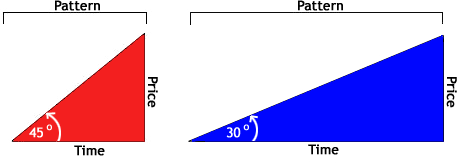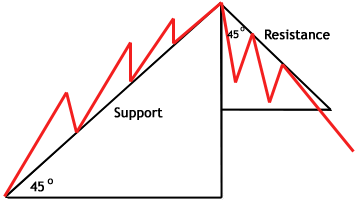Predicting the future is impossible, right? If he were around today, W.D. Gann would beg to differ. His first prophecy is believed to have happened during World War I when he predicted the Nov. 9, 1918, abdication of the Kaiser and the end of the war. Then in 1927, he wrote a book entitled "Tunnel Through The Air," which many believe predicted the Japanese attack on Pearl Harbor, and the air war between the two countries.
His financial predictions were perhaps even more profound. In early 1929, he predicted that the markets would probably continue to rally on speculation and hit new highs… until early April. In his publication, The Supply and Demand Letter, he delivered daily financial forecasts focusing on both the stock and commodity markets. As this daily financial publication gained notoriety, Gann published several books - most notably "Truth", which was hailed by the Wall Street Journal as his best work. Finally, he began releasing the techniques that he used to make these forecasts: the Gann studies.
What are the Gann Studies?
In 1908, Gann discovered what he called the "market time factor," which made him one of the pioneers of technical analysis. To test his new strategy, he opened one account with $300 and one with $150. It turned out to be wildly successful: Gann was able to make $25,000 profit with his $300 account in only three months; meanwhile, he made $12,000 profit with his $150 account in only 30 days! After his results were verified, he became famous on Wall Street as one of the best forecasters of all time.
Here's how his techniques work. Gann based predictions of price movements on three premises:
Based on these three premises, Gann's strategies revolved around three general areas of prediction:
Price study - This uses support and resistance lines, pivot points and angles.
Time study - This looks at historically reoccurring dates, derived by natural and social means.
Pattern study - This looks at market swings using trendlines and reversal patterns.

Fig 1
Figures such as these are the building blocks of the Gann studies.
Constructing Gann Angles
Before we begin, it is important to realize that this form of analysis - like most forms of technical analysis - is not set in stone but constructed out of empirical methods. Without further ado, here is the process used to construct a Gann angle:
1) Determine the time units - This is one of the empirical processes. One common way to determine a time unit is to study the stock's chart and take note of distances in which price movements occur. Then, simply put the angles to the test and determine their accuracy. Most people use intermediate-term (such as one to three-month) charts for this as opposed to long-term (multi-year) or short-term (one to seven-day) charts. This is because, in most cases, the intermediate-term charts produce the optimal amount of patterns.
2) Determine the high or low from which to draw the Gann lines - This is the second empirical process, and the most common way to accomplish it is to use other forms of technical analysis--such as Fibonacci levels or pivot points. Gann himself, however, used what he called "vibrations" or "price swings." He determined these by analyzing charts using mathematical theories like Fibonacci.
3) Determine which pattern to use - The two most common patterns are the 1x1 (left figure above), the 1x2 (right figure above), and the 2x1. These are simply variations in the slope of the line. For example, the 1x2 is half the slope of the 1x1. The numbers simply refer to the number of units.
4) Draw the patterns - The direction would be either downward and to the right from a high point, or upward and to the right from a low point.
5) Look for repeat patterns further down the chart - Remember this technique is based on the premise that markets are cyclical.
Again, this requires some fine-tuning with experience in order to perfect. Because of this, the results will vary from person to person. Some people, like Gann, will experience extraordinary success, while others - who don't use such refined techniques - will experience sub-par returns. However, if the system is followed and sufficient research is put into finding the optimal requirements, above-average returns should be attainable. But remember, technical analysis is an odds game -add more technical indicators to increase your chances of a successful trade.
Using Gann Angles
Gann angles are most commonly used as support and resistance lines. But many studies have support and resistance lines. What makes this one so important? Well, Gann angles let you add a new dimension to these important levels - they can be diagonal.

Fig 2
Here you can see how Gann angles can be used to form support and resistance levels. Diagonal trendlines are commonly used to determine times to add to existing long positions, to determine new lows and highs (by finding significant breaks of the trend line), and to help discern the overall trend.
In Summary
Is it possible to predict the future? W.D. Gann probably thought so, and seemingly proved it with his wildly successful returns. The system is relatively simple to use, but difficult to master. After all, it was Gann's uncanny ability to fine-tune his techniques that led him to enormous profits - the average investor is not likely to obtain these kinds of returns. Like many technical tools, Gann angles are best used in conjunction with other tools to predict price movements and profit.
Justin Kuepper can be contacted at InternationInvest
His financial predictions were perhaps even more profound. In early 1929, he predicted that the markets would probably continue to rally on speculation and hit new highs… until early April. In his publication, The Supply and Demand Letter, he delivered daily financial forecasts focusing on both the stock and commodity markets. As this daily financial publication gained notoriety, Gann published several books - most notably "Truth", which was hailed by the Wall Street Journal as his best work. Finally, he began releasing the techniques that he used to make these forecasts: the Gann studies.
What are the Gann Studies?
In 1908, Gann discovered what he called the "market time factor," which made him one of the pioneers of technical analysis. To test his new strategy, he opened one account with $300 and one with $150. It turned out to be wildly successful: Gann was able to make $25,000 profit with his $300 account in only three months; meanwhile, he made $12,000 profit with his $150 account in only 30 days! After his results were verified, he became famous on Wall Street as one of the best forecasters of all time.
Here's how his techniques work. Gann based predictions of price movements on three premises:
- Price, time and range are the only three factors to consider.
- The markets are cyclical in nature.
- The markets are geometric in design and in function.
Based on these three premises, Gann's strategies revolved around three general areas of prediction:
Price study - This uses support and resistance lines, pivot points and angles.
Time study - This looks at historically reoccurring dates, derived by natural and social means.
Pattern study - This looks at market swings using trendlines and reversal patterns.

Fig 1
Figures such as these are the building blocks of the Gann studies.
Constructing Gann Angles
Before we begin, it is important to realize that this form of analysis - like most forms of technical analysis - is not set in stone but constructed out of empirical methods. Without further ado, here is the process used to construct a Gann angle:
1) Determine the time units - This is one of the empirical processes. One common way to determine a time unit is to study the stock's chart and take note of distances in which price movements occur. Then, simply put the angles to the test and determine their accuracy. Most people use intermediate-term (such as one to three-month) charts for this as opposed to long-term (multi-year) or short-term (one to seven-day) charts. This is because, in most cases, the intermediate-term charts produce the optimal amount of patterns.
2) Determine the high or low from which to draw the Gann lines - This is the second empirical process, and the most common way to accomplish it is to use other forms of technical analysis--such as Fibonacci levels or pivot points. Gann himself, however, used what he called "vibrations" or "price swings." He determined these by analyzing charts using mathematical theories like Fibonacci.
3) Determine which pattern to use - The two most common patterns are the 1x1 (left figure above), the 1x2 (right figure above), and the 2x1. These are simply variations in the slope of the line. For example, the 1x2 is half the slope of the 1x1. The numbers simply refer to the number of units.
4) Draw the patterns - The direction would be either downward and to the right from a high point, or upward and to the right from a low point.
5) Look for repeat patterns further down the chart - Remember this technique is based on the premise that markets are cyclical.
Again, this requires some fine-tuning with experience in order to perfect. Because of this, the results will vary from person to person. Some people, like Gann, will experience extraordinary success, while others - who don't use such refined techniques - will experience sub-par returns. However, if the system is followed and sufficient research is put into finding the optimal requirements, above-average returns should be attainable. But remember, technical analysis is an odds game -add more technical indicators to increase your chances of a successful trade.
Using Gann Angles
Gann angles are most commonly used as support and resistance lines. But many studies have support and resistance lines. What makes this one so important? Well, Gann angles let you add a new dimension to these important levels - they can be diagonal.

Fig 2
Here you can see how Gann angles can be used to form support and resistance levels. Diagonal trendlines are commonly used to determine times to add to existing long positions, to determine new lows and highs (by finding significant breaks of the trend line), and to help discern the overall trend.
In Summary
Is it possible to predict the future? W.D. Gann probably thought so, and seemingly proved it with his wildly successful returns. The system is relatively simple to use, but difficult to master. After all, it was Gann's uncanny ability to fine-tune his techniques that led him to enormous profits - the average investor is not likely to obtain these kinds of returns. Like many technical tools, Gann angles are best used in conjunction with other tools to predict price movements and profit.
Justin Kuepper can be contacted at InternationInvest
Last edited by a moderator:
